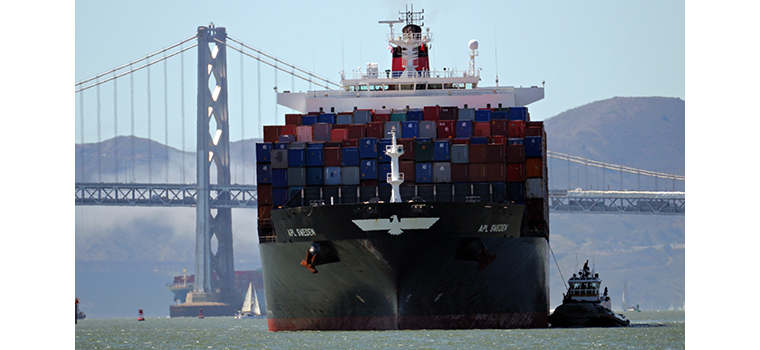A shipping industry trend toward bigger, more efficient container vessels is paying off at the Port of Oakland, where the trend driving "mega-vessel" deployments on a less frequent basis is being welcomed by stakeholders.

This year through April, the Port of Oakland’s volume was up 2.8 percent over last year, even though the number of vessels arriving at the port was down 5.6 percent. Photo courtesy of Port of Oakland
BY PATRICK BURNSON
Published: June, 2017
A shipping industry trend toward bigger, more efficient container vessels is paying off at the Port of Oakland, where the trend driving “mega-vessel” deployments on a less frequent basis is being welcomed by stakeholders.
According to spokespeople for the Port of Oakland, container throughput is still ports’ most valued metric. This year’s volume through April was up 2.8 percent over last year, even though the number of vessels arriving at the port was down 5.6 percent. Another happy consequence of this trend, say spokespeople, is that because fewer but larger ships are carrying more cargo to Oakland, dock congestion is eased and vessel emissions are reduced.
“Shipping lines have moved to larger vessels to consolidate cargo and cut costs,” says Port of Oakland Maritime Director John Driscoll. “We’re the beneficiaries because we can handle volume growth efficiently and sustainably.”
The port reports that 539 ships visited Oakland in the first four months of 2017. That is compared to 571 calls during the same period a year ago. The port says the average-size vessel visiting Oakland has the capacity to carry more than 8,000 20-foot containers. The average was closer to 5,000 just three years ago. Ships with capacity for 14,000 containers—the largest in North America—call Oakland weekly.
The port said 2017 containerized import volume in Oakland increased 3.5 percent through April. Export volume was up three percent.
In anticipation of servicing more large vessel calls, Oakland is also investing in its infrastructure. Work has recently begun at the port to heighten four massive ship-to-shore cranes, as the existing 366-foot models will be raised 27 feet in a nine-month project. The port said it’s raising the cranes at Oakland International Container Terminal (OICT) in partnership with SSA Marine, the terminal operator. Cost of the project is estimated at about $14 million.
Technicians began the exacting work of crane-raising last month, pulling the first three-million-pound unit off its guide rails. In a delicate, 90-minute procedure, it was shuttled to the eastern edge of OICT’s Oakland Estuary dock. That’s where the work will take place beginning next month.
Over a nine-week period, engineers will brace the crane on supports, cut away its lower legs and affix extensions. They’ll return the heightened crane to duty before withdrawing the next one for raising, probably in August.
While crane-raising is part of an overall effort to strengthen Oakland’s competitiveness among West Coast ports, other projects are underway or expected to begin soon. These include doubling the size of the nearby TraPac marine terminal, constructing a 287,000-square foot “cool port” for refrigerated cargo transport, and developing the first 27 acres of a Seaport Logistics Complex that will attract additional imports and exports.
All of this news is likely to also be welcomed by a diverse group of cargo stakeholders who have addressed environmental concerns ranging from cleaner air to climate change. The freight transport required to send goods all over the world accounts for about seven percent of global carbon emissions, making it a significant contributor to climate change and an important potential climate leadership opportunity, said Emilie Prattico, manager of the San Francisco-based sustainability nonprofit BSR.
“Unfortunately, there are many barriers to achieving climate leadership for the transport sector, from the slow turnover of inventory and infrastructure to the high capital costs and uncertainty characterizing many potential low-carbon solutions,” Prattico said.
There is good news, however, according to Prattico. Many levers already exist to improve performance, including greater route and vehicle efficiency, modal shifts (using different transport modes over a single route), and the scaling of low-carbon fuels. “What’s more is, many of these levers have a proven positive return on investment—particularly energy efficiency measures—and efficient, low-carbon transport systems also have significant benefits,” she said.
Prattico said that BSR works with its network of more than 250 member companies and other partners to develop sustainable business strategies and solutions through consulting, research and cross-sector collaboration. BSR also includes the Clean Cargo Working Group (CCWG), a leadership initiative involving major brands, cargo carriers and freight forwarders dedicated to reducing the environmental impacts of global goods transportation and promoting responsible shipping.

